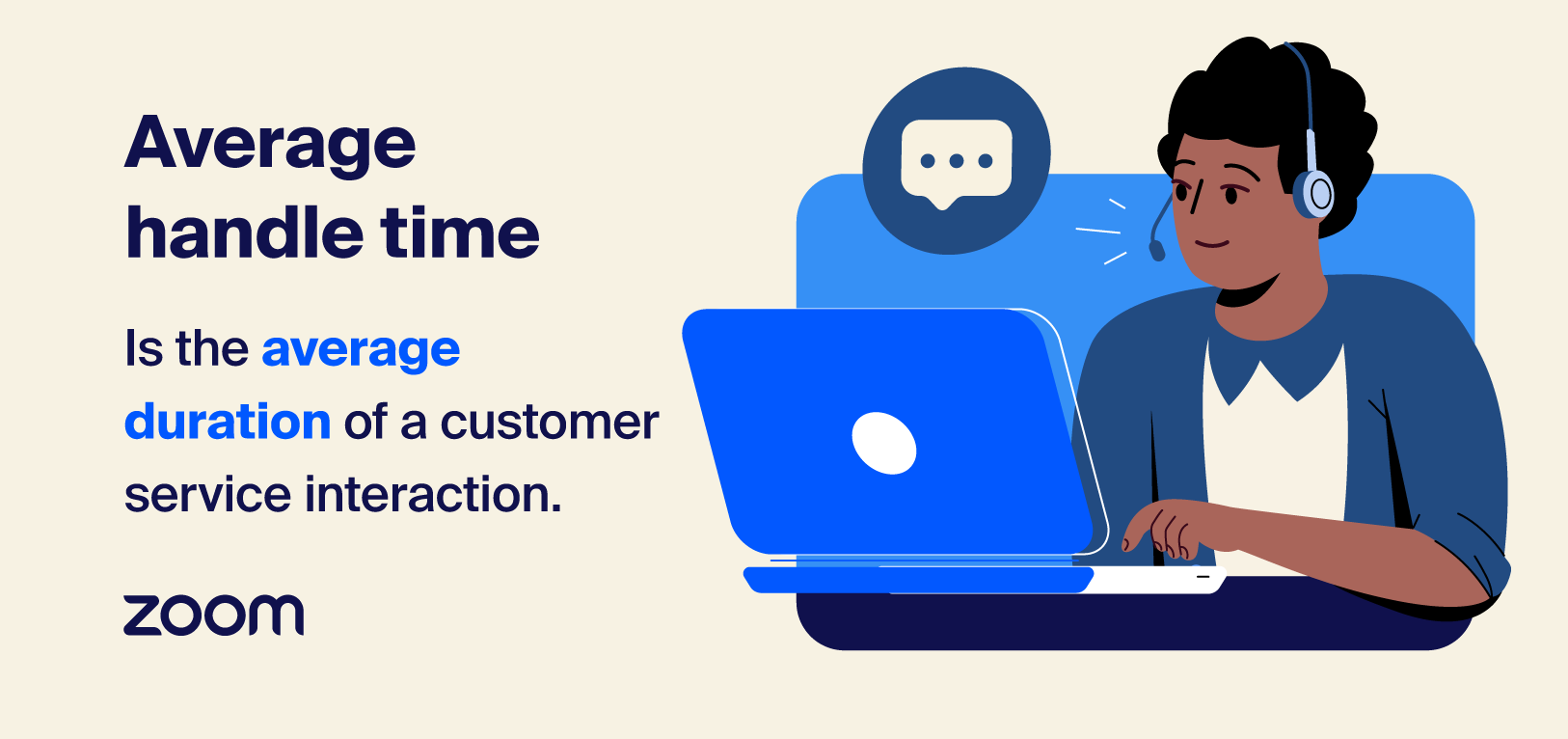
Meet Zoom AI Companion, your new AI assistant!
Boost productivity and team collaboration with Zoom AI Companion, available at no additional cost with eligible paid Zoom plans.
Updated on August 25, 2025
Published on August 25, 2025


Every minute your customers spend waiting for service costs them time and can lead to frustration. For businesses, those minutes translate to decreased customer satisfaction and potentially lost revenue opportunities. High average handle times (AHT) can lead to upset customers, overwhelmed agents, and declining satisfaction scores that impact your bottom line.
In this article, we cover everything contact centers need to know about average handle time, why it matters for your contact center, and best practices to optimize this critical metric while maintaining exceptional customer experiences.

Average handle time measures how long the average customer service interaction takes from start to finish. Originally, this valuable key performance indicator (KPI) was used only for calls. But in modern contact centers, it also measures interactions for emails and live chat.
AHT typically includes the total time an agent spends talking with a customer, any hold time during the interaction, and the follow-up work required after the conversation ends.
For most industries, a good average handle time falls near the six-minute mark, but this can vary widely based on business type, service needed, and customer experience goals.
Industry-level AHT data from a 2004 Cornell University report shows averages ranging from about 4.7 minutes in financial services and retail to just under nine minutes in business and IT services. More recent industry estimates place most AHT benchmarks in the three- to four-minute range, depending on factors such as interaction channel, issue complexity, and agent expertise.
Today’s customers expect efficient support. By monitoring and optimizing AHT, you can deliver faster resolutions that meet customer expectations for speed and convenience while maintaining high-quality service.
Tracking AHT metrics helps identify operational inefficiencies and workflow issues that may be slowing down your agents. These insights point to opportunities for process improvements and better cross-departmental collaboration.
By analyzing handle time against operational costs, you can transform your contact center from a cost center into a revenue driver. Reducing AHT allows for handling more interactions with the same resources, improving overall efficiency and profitability.
AHT data provides valuable information for staffing decisions, schedule optimization, and resource allocation. Understanding typical resolution times helps managers predict staffing needs and adjust schedules to match contact volume patterns.
When specific products or services consistently generate longer handle times, it may indicate a need for improvements. This could mean better documentation, simplified features, or enhanced customer education resources to minimize support requirements.

The formula for calculating AHT varies depending on which communication channel you’re measuring. Here are the three most common formulas for different support channels:
Call AHT formula
For phone-based interactions, average handle time considers the complete customer journey from start to finish.
| AHT = (Total talk time + total hold time + follow-up time) / Total number of calls |
Live chat AHT formula
To calculate chat interactions, the calculation focuses on total handle time across all conversations.
| AHT = Total handle time / Total number of chats |
Email AHT formula
Email average handle times measure the total time spent reading and responding to the email, the time it takes to research the solution, and the time a customer waits for responses and the resolution.
| AHT = (Total time reading and replying + total resolution time + total customer wait time) / Total number of emails |
Let’s say your contact center handled 120 calls yesterday with the following metrics:
The AHT formula for yesterday’s calls would be: (900 + 650 + 250) / 120 = 15 minutes
In this example, your average handle time would be 15 minutes per call — nine minutes higher than the industry benchmark of six minutes — suggesting opportunities for optimization.
Improving your contact center’s efficiency requires a strategic approach to AHT reduction. Here are eight practical methods you can use to decrease handle times while maintaining quality service:
Well-trained agents resolve issues more efficiently. Invest in comprehensive onboarding and ongoing education programs that include:
Data-driven insights reveal performance patterns and improvement opportunities. Monitor key metrics including:
After you’ve gathered this data, it’s important to ask, “Why?” By digging deeper into the data, you can better understand why some of these metrics are too high or too low. For example, long wait times could be due to understaffing or long resolution times.
Anticipating customer needs prevents issues before they generate support requests. Effective strategies include:
Self-service resources empower customers to find answers independently while reducing agent workload and leading to shorter interaction times. Develop comprehensive:
Artificial intelligence can dramatically improve efficiency across your contact center operations. Implement AI solutions like:
The best AI tools can also escalate more complex issues that require a human touch to live agents.
While agent metrics can help improve internal processes, AHT insights help identify opportunities to enhance overall customer experiences. Use data to:
Brainstorm customer experience strategies
Streamlined workflows eliminate unnecessary steps that extend handle times. You can automate:
The right technology empowers agents to resolve issues efficiently. Equip your team with:
Comprehensive analytics dashboards for performance insights
Optimizing average handle time isn’t just about speed — it’s about striking the perfect balance between efficiency and quality service. Agents should be trained to resolve issues efficiently without rushing interactions. Spending a little more time can help avoid multiple follow-ups and unsatisfied customers. The most successful contact centers recognize that pushing for the shortest possible handle time can sometimes compromise customer satisfaction.
With Zoom Contact Center, you can work toward this balance with our comprehensive suite of tools designed specifically to improve AHT while maintaining exceptional customer experiences. Our unified platform integrates voice, video, chat, and SMS capabilities with powerful analytics, AI assistance, and automation tools that streamline every aspect of customer interaction.
If you’re ready to reduce your AHT and experience the benefits of Zoom Contact Center, connect with a Zoom expert today.